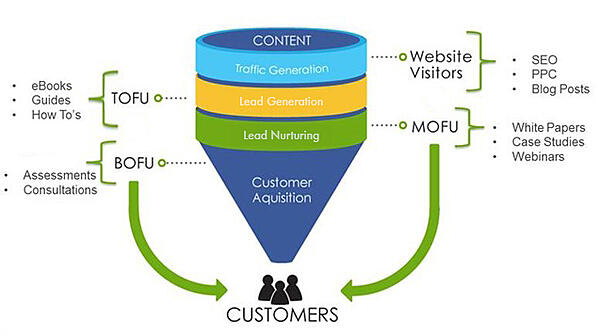Here's the Difference Between TOFU, MOFU, and BOFU Content Offers
Discover how the right content can guide people from first click to final sale.
If you are already using content and inbound marketing, then you know that CTAs and content offers are a vital ingredient in your overall marketing efforts. And, you know that each stage of the conversion funnel requires its own unique type of content.
For instance, eBooks and checklists are excellent top-of-funnel (TOFU) content offers. And webinars can be great middle-of-funnel (MOFU) offers. But at one point or another, you may have wondered, “Wait… can’t webinars be TOFU offers too?”
The answer is yes.
And this is where things can get tricky. Sometimes it’s difficult to know exactly what content would work best at which stage of the funnel. This is a pretty big problem. After all, you need to be able to match the right content to your persona’s needs at each stage in their buyer journey. So let’s dig in and define the difference between TOFU, MOFU, and BOFU offers.
What is the Inbound Marketing Conversion Funnel?
First, let’s review how the inbound process aligns with each key stage of the conversion funnel…
- Generate Site Traffic: To begin with, you attract site visitors through quality blog posts, social media, and keywords.
- Convert Traffic to Leads: Once visitors are on your site, you offer compelling TOFU content offers like eBooks and How-to-Guides to generate leads.
- Nurture Leads: Once a visitor becomes a lead (they’ve clicked on your CTA, filled out a form on your content offer landing page, and clicked submit), then you’re ready to nurture that lead. If the lead is early in her buyer journey, you’ll want to build the relationship with additional relevant TOFU offers. As you nurture the lead and she moves further down the buyer journey, then MOFU offers such as case studies come into play.
- Convert Leads to Sales: Finally, BOFU offers help to convert a lead into a customer. These offers include assessments and consultations.

And here's how to determine exactly what type of content aligns with each stage of the funnel...
Defining Content Offers by Funnel Stage
Top of Funnel (TOFU)
TOFU content should focus on common issues that your persona faces. This content is purely educational and centers around helping your target audience — without explicitly promoting your own business.
EXAMPLE: If your business sells widgets, a TOFU offer might be The Definitive Guide to Using Widgets.
Middle of Funnel (MOFU)
MOFU content should be about your business, your solution and your brand. In these offers, you want to help leads establish buying criteria. You’ll also want to illustrate what is most important to product/service satisfaction and why your products or services are the best choices.
EXAMPLE: If your business sells widgets, a MOFU offer might be My Brand’s Widgets vs. Brand X Widgets: A Side-By-Side Comparison.
Bottom of Funnel (BOFU)
BOFU offers present you with a unique opportunity to address exactly how your product or solution meets the specific needs of the prospective buyer.
BOFU offers like free consultations and demos provide you with an excellent opportunity to ask questions and gain deeper insights into the buyer’s unique situation. With this knowledge, you can help your prospective buyer discover how exactly how your product/service can meet her specific needs and challenges – including addressing any reservations she may have about buying from you.
Mapping Funnel Content to Buyer Journey Needs
Sometimes it may be difficult to know exactly what content would work best at which stage of the funnel; however, to effectively market to your audience, you must match the right content with your persona's needs at each stage in their buyer journey. To ensure this, consider that:
-
- TOFU content should focus on common issues that your persona faces.
- MOFU content should be about your business, your solution, and your brand.
- BOFU content should address exactly how your product or solution meets the specific needs of the perspective buyer.
Happy funnel building!
Editor's Note: This post was originally published in December 2014 and has been updated for accuracy and comprehensiveness.


